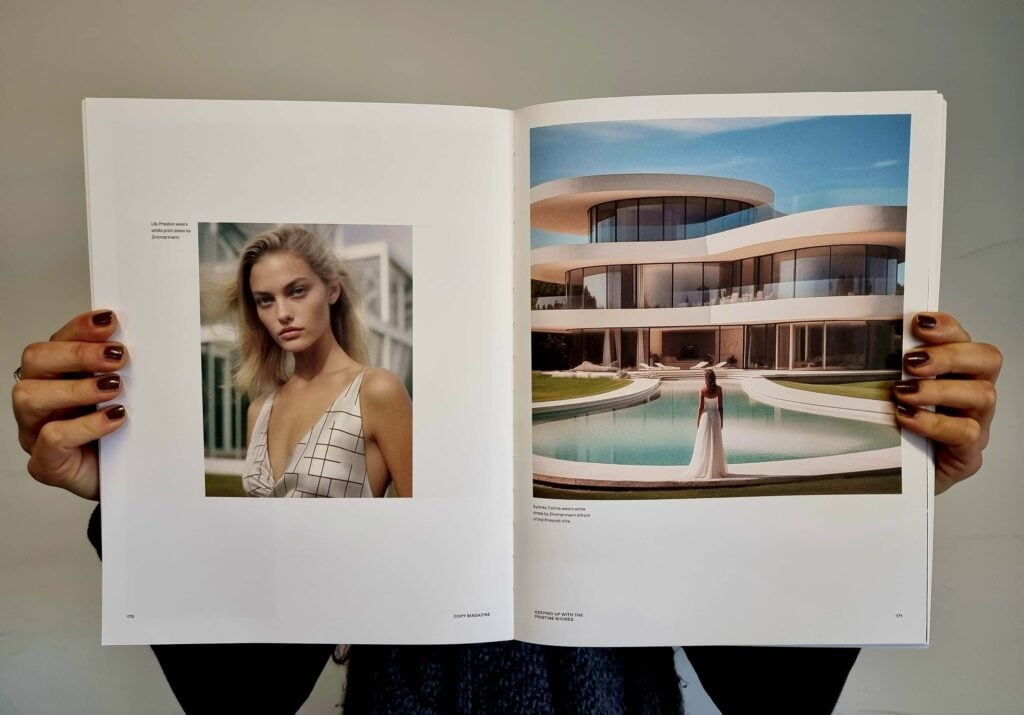In this year 2023, monopolized by the debate on artificial intelligence, could there be a lack of a fashion magazine published thanks to these technologies? An answer came last August 2023, when the 41-year-old creative director in Sweden Carl-Axel Wahlström published the paper semi-annually COPYwhich he defines as “the first AI fashion magazine“.
The content of the first fashion magazine created with artificial intelligence
“Nothing you see here is real.” It is the first sentence you read when leafing through the extensive magazine COPY (333 pages for this first edition, €30). However, it is difficult to believe this statement. The models, their names, their looks seem so real that they are confusing. Both real and strangely perfect. The magazine, like an ordinary fashion magazine, is divided into a series of nine thematic editorials: there is one about cosmetics, one about the world of Formula 1, one about the millionaires of the Hamptons and one about a great classic – about women in careers. The paper is high quality, the photos are high quality, some of the paper is glossy and some is opaque. However, all sites have one thing in common: the photos were not taken by anyone, the models do not exist, and the texts and captions have no author. Everything is the result of instructions given to you In the middle of the journey for pictures and too ChatGPT for the texts.
Actually the original goal of the creator of COPY, Carl-Axel Wahlström, aims to highlight the potential arising from the synergy between human creativity and artificial intelligence. The editorial project then pursued its goals and became a useful platform for some reflections on the fashion system, as well as a means that also manages to make fun of the excesses of this world.
The birth of COPY, AI’s fashion magazine
When Wahlström started interacting with AI, he didn’t do it to create a magazine: he played with ChatGPT, as we all have done in the last few months, he was simply fascinated by it. “I was amazed and in love with all this technology” explains in an interview with Business Insider on September 6, 2023. Then something changed. The idea came from curiosity.
As we scroll through the pages, we are confronted with the magnetic looks of women of different ethnic groups, with high cheekbones and pink cheeks, masterfully sculpted faces, long blonde, black, red, tousled, straight, open or gathered hair, full lips and a smile that shines with emotion. from the camera’s flash.
Wahlström worked with Midjourney software to create these images, but they were later retouched by real people. “To finish editing an image” he says Business Insider “Even ten hours of work were required“. Artificial intelligence, yes, but obviously accompanied by a lot of editorial skill.

The behavior of artificial intelligence in fashion images
Midjourney is one of the most commonly used artificial intelligence software for creating images according to instructions. In reality, Midjourney does not create new images, but reworks photos found on the Internet based on the clues it receives to create new, seemingly original images. So if we ask artificial intelligence to “create” photos of models, it will return images that are the result of beauty standards, stereotypes and general aesthetic standards that have existed since the birth of the Internet until today.
Midjourney therefore appears as a mirror of the imagination of the last 20 years: a continuous look at the aesthetics of the past and their reinterpretation. “If you ask Midjourney to create a 2022 fashion collection, the AI isn’t sure what to do. Instead, there are many more elements online to explore references to fashion from the eighties or nineties. explains Wahlström in the August 2023 interview for Fashion.
COPY. Editorial project reflections and irony
The project lends itself to a number of questions, which were also the questions of the founder. COPY, which presents itself as a summary of the aesthetic ideals of past decades, also shows how these in turn were influenced by fashions. Is seeking conformity at all costs healthy when everything is about to change? Could AI help overcome stereotypes and clichés about women’s aesthetics?
However, this depth of reflection was not one of the main aims of the first edition of COPY. If you leaf through the magazine and read the captions, it becomes clear that Wahlström was more interested in ironizing, provoking and questioning the fashion and image industry. The world of cosmetics and excesses in the display of money are also under scrutiny. “Who needs Cinderella’s fairy godmother when she has a credit card and crazy taste?” one of the captions asks.
Laura Buratti